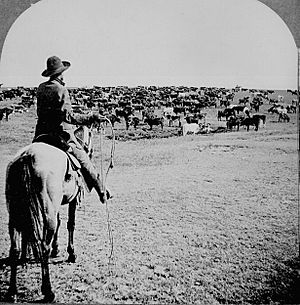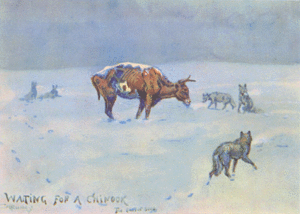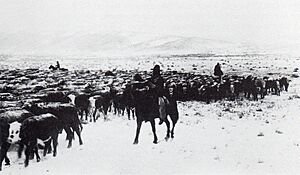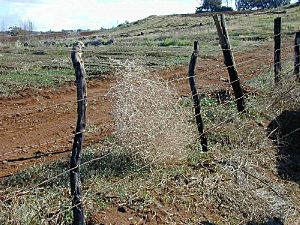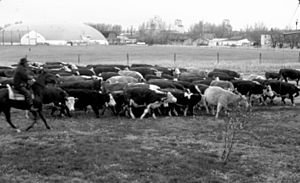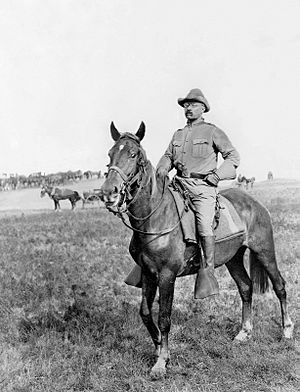Cattle drives in the United States facts for kids

Cattle drives were a huge part of life in the American West during the 1800s. Imagine millions of cattle, like the famous Texas Longhorn, being herded by cowboys across long distances. This happened mostly between 1866 and 1886. About 20 million cattle were moved from Texas all the way to special train stations, called railheads, in Kansas. From there, they were shipped to big meat markets in Chicago and other cities in the East.
Because these drives covered such long distances, cowboys and animals needed places to rest. This led to the creation of "cow towns" all across the frontier. The image of the cowboy riding across the plains has become a famous symbol of the American West, thanks to many stories and movies. Even today, some cattle drives still happen in the West.
Contents
How Cattle Were Moved
Moving cattle was a balancing act. Cowboys wanted to get the cattle to market quickly, but they also needed to make sure the animals stayed healthy and gained weight.
A typical cattle drive, like one from Texas to Kansas, usually involved about 3,000 cattle. To manage such a large herd, a team of at least 10 cowboys was needed. Each cowboy had about three horses. Cowboys worked in shifts, watching the cattle day and night. During the day, they guided the herd in the right direction. At night, they kept an eye on the cattle to prevent them from stampeding (running away wildly) or being stolen.
The crew also included a cook who drove a chuck wagon. This wagon was usually pulled by oxen and carried food and supplies. The cook was a very important and respected member of the team. Besides preparing meals, they also handled medical supplies and knew a lot about basic medicine. A horse wrangler was also part of the crew. Their job was to look after the remuda, which was the group of spare horses. The wrangler was often a younger cowboy or someone with less experience.
Where Did Cattle Drives Begin?
Long-distance cattle driving actually started in Mexico, California, and Texas a long time ago. The Spanish people brought ranching to the New World and began driving herds north from Mexico in the 1540s. Even small Spanish settlements in Texas made money by driving horses and cattle into Louisiana, though this trade was often against the law.
Cattle drives also happened in the United States, but not as often. Sometimes, even hogs were herded over long distances. For example, in 1815, a traveler named Timothy Flint saw a group of over 1,000 cattle and pigs being driven from Ohio to Philadelphia.
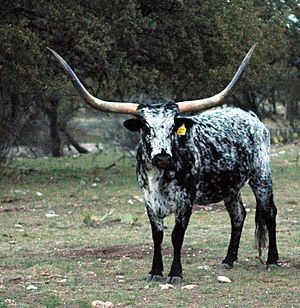
By 1836, ranchers in Texas started driving cattle along a "Beef Trail" to New Orleans. In the 1840s, these drives expanded north into Missouri. Towns like Sedalia, Baxter Springs, Springfield, and St. Louis became important markets. The Shawnee Trail was a key route in Texas during the 1840s.
However, by 1853, farmers in Missouri started blocking the cattle. The Texas Longhorns carried ticks that spread a disease called Texas fever. The Texas cattle were immune, but the ticks infected local cattle. Farmers formed groups to stop the herds and even killed Texas cattle that entered their counties. A law was passed in 1855 banning diseased cattle from being brought into Missouri. So, cowboys tried to drive their herds through eastern Kansas, but farmers there also protested and passed a similar law in 1859.
During the 1850s, more people moving west and the need for freight transportation also increased the demand for oxen. Thousands of Longhorns were trained to be work oxen. Some herds were even driven to Chicago, and at least one herd made it all the way to New York! The gold rush in California in the 1850s also created a big demand for beef.
The American Civil War (1861-1865) stopped access to eastern markets. During the war, the Shawnee Trail was hardly used. Texas cattle numbers grew a lot during this time, but after the war, they couldn't be sold for much money in Texas – sometimes as little as $2 per head. By 1866, there were an estimated 200,000 to 260,000 extra cattle.
In 1865, after the Civil War, a man named Philip Danforth Armour opened a meat packing plant in Chicago. As the meat packing industry grew, the demand for beef went way up. By 1866, cattle could be sold in northern markets for as much as $40 per head. This made it very profitable to herd cattle, especially from Texas, over long distances to market.
The Golden Age of Cattle Drives
By 1867, a special cattle shipping center opened in Abilene, Kansas, run by Joseph G. McCoy. This town was built west of farming areas and close to a train station. Abilene quickly became a major hub for shipping cattle, sending out over 36,000 cattle in its first year!
The path from Texas to Abilene became known as the Chisholm Trail. It was named after Jesse Chisholm, who helped mark the route. This trail went through what is now Oklahoma, which was then Indian Territory. There weren't many problems with Native Americans, who usually allowed the cattle herds to pass through if they paid a small fee of ten cents per head. Later, other trails branched off to different train stations, like those in Dodge City and Wichita, Kansas. By 1877, Dodge City, Kansas, which was the biggest of the cattle-shipping towns, shipped out 500,000 cattle!
Other important cattle trails were also created, moving further west. In 1867, the Goodnight-Loving Trail opened up new areas in New Mexico and Colorado for Texas cattle. Tens of thousands of cattle were soon driven into Arizona. In Texas itself, cattle ranching grew quickly as Americans started eating more beef than pork. Towns like Caldwell, Dodge City, Ogallala, and Cheyenne became famous because of the trail drivers who visited them.
What Were Cow Towns Like?

Cow towns thrived between 1866 and 1890. These were towns where railroads reached, making them perfect places to gather and ship cattle. Abilene, Kansas was the first famous cow town. Other Kansas towns, like Wichita and Dodge City, later became popular or shared the business. In the 1880s, Dodge City even called itself the "cowboy capital of the world."
Communities in other states, such as Ogallala, Nebraska; Cheyenne, Wyoming; Miles City, Montana; and Medora, North Dakota, also served the cattle trade. Amarillo, Fort Worth, and Wichita Falls in Texas, along with Prescott, Arizona, Greeley, Colorado, and Las Vegas, New Mexico, were important in their regions.
The most famous cow towns, like Abilene, were railheads. This meant they were the end of the line for the cattle drives, where the herds were loaded onto trains and sent to big meat markets like the Chicago stockyards. Many smaller towns along the way supported the open range lands where cattle grazed freely. These cow towns were often lively places, filled with buffalo hunters, railroad workers, and freighting teams during their busiest times. Cattle owners used these towns as their main places for buying and selling cattle.
Why Did the Open Range End?
As the cattle industry grew, ranchers needed even more open range land. So, many ranchers moved into the northwest, where there were still huge areas of unsettled grasslands. Texas cattle were herded north into the Rocky Mountain west and the Dakotas. For example, in 1866, Nelson Story successfully drove about 1,000 Longhorn cattle into Montana using the Bozeman Trail. Big cattle owners like Conrad Kohrs built huge ranches in the northern Rockies. At its peak, Kohrs owned 50,000 cattle grazing on 10 million acres of land across four states and two Canadian provinces! He shipped 10,000 cattle every year to the Chicago stock yards.
However, several problems led to the end of the open range. Too many cattle grazing in one area (overgrazing), combined with dry weather and the extremely harsh winter of 1886–1887, wiped out a lot of the open-range cattle business in Montana and the Great Plains. After these events, ranchers started using barbed wire to fence in their ranches. This helped them protect their own grazing lands from other animals.
By the 1890s, herds were still sometimes driven from the Panhandle of Texas to Montana. But by then, railroads had spread across most of the country. Also, meat packing plants were built closer to the main ranching areas. This meant that long cattle drives to the railheads were no longer needed. So, the age of the open range and the era of huge cattle drives came to an end.
Modern Cattle Drives
Smaller cattle drives continued until at least the 1940s. Before modern cattle trucks were common, ranchers still needed to herd cattle to local train stations to be transported to stockyards and packing plants.
Today, cattle drives are mostly used to gather cattle within a ranch or to move them from one pasture to another. This usually only takes a few days. Because cattle drives are such an important part of American history, some working ranches now offer them as tourist events. Guests can pay to join in and help move cattle from one feeding ground to the next, similar to a guest ranch. While horses are still used in many places, especially in rough or mountainous areas, all-terrain vehicles (ATVs) are also common. When cattle need to move longer distances, they are now shipped by truck.
Sometimes, events that celebrate the western lifestyle include cattle drives. For example, the Great Montana Centennial Cattle Drive in 1989 celebrated Montana's 100th birthday. About 2,400 people, 200 wagons, and 2,800 cattle traveled 50 miles in six days to raise money for college scholarships. Similar drives have happened since then.
The Iconic Cowboy Culture
The cowboy's unique working clothes and gear became very popular. Much of it came from the Mexican vaquero (cowboy). The high-crowned cowboy hat, high-heeled boots, leather chaps, pistol, rifle, lariat, and spurs were all practical tools needed for working with cattle. They also looked fascinating on the movie screen!
Cattle Drives in Stories and Movies
Cattle drives were a big part of many Hollywood films and TV shows, especially when westerns were popular. One of the most famous movies is Red River (1948), starring John Wayne. Like many films, Red River often made the dangers of cattle driving seem even bigger than they were. More recently, the movie City Slickers (1990) was about a group of city people on a guest ranch cattle drive. In the 1958 film Cowboy, Glenn Ford plays a tough trail boss, and Jack Lemmon plays a city person who joins the drive.
The long-running TV show Rawhide (1959–1965), starring Clint Eastwood, was about cowboys driving 3,000 cattle along the Sedalia trail from San Antonio, Texas, to the train station in Sedalia. Episode four of the 1970s miniseries Centennial, called The Longhorns, showed a cattle drive from central Texas to northeastern Colorado. The 1980s miniseries Lonesome Dove, based on a famous novel, was all about a cattle drive from South Texas to Montana.
Over time, people began to see cowboys as symbols of courage and dedication. Cowboys had to herd cattle through tough places, whether it was quicksand, fast-flowing rivers, or thick brush.
|


